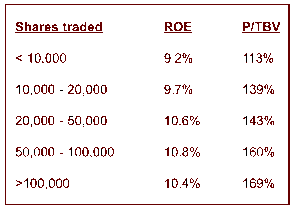Stock liquidity is a frequent topic of discussion, particularly amongst smaller, newly public institutions that are navigating the markets and interacting with institutional investors for the first time. Earlier this year, amidst the crisis in the banking sector, this topic was top of mind for community bankers and investors in these institutions. In this article, we take a closer look at share liquidity and the impact on bank stock valuations, which yields some surprising conclusions and, I think, interesting takeaways.
Liquidity and valuation are clearly intertwined. There are several reasons why share liquidity is important, but none more so than how it impacts the ease or difficulty in opening and closing positions in individual stocks. This risk tends to be glossed over in orderly markets but is magnified in times of crisis, as we saw earlier this year. While the pain felt across the bank sector was highly correlated in the early stages of the pandemic, it began to diverge meaningfully amidst the initial rally in bank stocks. The most liquid stocks moved quickly higher, while forced selling of relatively illiquid stocks near the lows inhibited recovery in these names, a dynamic that persisted until the broad-based sector rally following the vaccine announcements earlier this month.
Now, periods of crisis obviously aren’t the norm, but are thought-provoking nonetheless. As we hopefully continue to progress towards a “new normal”, the intriguing question to me is the extent of the correlation between stock liquidity and valuation. In other words, are there clear breakpoints in a more orderly market, below which the lack of stock liquidity impacts valuation or does it just not matter all that much?
Assumptions. First, I used TBV multiples as of 12/31/19, given that valuations have been skewed due to the pandemic and its follow-on implications. If we’re trying to get a sense for what the “new normal” looks like, then better to use data from the “old normal” rather than the distortions through a crisis period. Second, I looked at average daily volume over a 52-week period (rather than the typical 3 months), again, given the extreme volatility in trading volumes we’ve seen since the pandemic.
For many very small banks, liquidity is more consequential for valuation than profitability! I found there were two breakpoints in liquidity below and above which the disparity in valuation was material. For stocks trading less than 10,000 shares per day, valuations were significantly discounted relative to the broader peer group, at around 113% of TBV on average (as of 12/31/19). For stocks trading between 10,000 and 50,000 shares per day, there was a material step-up in valuation, to 142% of TBV. We saw another big step-up in valuation – to around 160% of TBV — for stocks trading between 50,000 and 100,000 shares per day, and then a lesser valuation bump – to 169% — for stocks trading over 100,000 shares daily.
What was particularly interesting about these results is that amongst the group of relatively illiquid stocks, the correlation between valuation and trading volume was significantly higher than that between valuation and profitability. For example, stocks trading less than 10,000 shares per day posted a return on equity of 9.2% last year, whereas banks trading between 10,000 and 20,000 shares per day performed only slightly better, at 9.7%. In other words, the 50 basis point differential in profitability, in my mind, is much too small to account for such a significant gap in how these stocks were valued. Similarly, for stocks trading between 20,000 and 50,000 shares and between 50,000 and 100,000, there was essentially no difference in profitability (10.6% vs. 10.8%), and yet there was a notable differential in valuation (143% vs. 160%). Also furthering our case is the fact that there is a more noticeable improvement in profitability for banks with trading volume between 20,000 and 50,000 shares per day compared to the group trading 10,000 to 20,000 shares per day, and yet these two groups are valued very similarly (the latter at 139% of TBV; the former at 143%).
Five Important Strategic Takeaways from this Analysis
- For bank management teams, while maximization of fundamental performance is undoubtedly the primary driver of long-term intrinsic value, attention should also be paid to market mechanics, which is clearly impactful to valuation.
- For newly public banks or those generally lacking familiarity with the market, having the requisite talent on staff or trusted 3rd party advisor to help the Board and management make informed decisions is paramount!
- For savvy acquirers of small banks, it is important to recognize that a severely discounted valuation of a public target might be solely reflective of share illiquidity. This could result in a more attractive acquisition scenario, vis a vis a target with a similarly attractive franchise and comparable fundamental performance that trades just a little bit more actively.
- Small public banks thinking about a large scale share repurchase should look to ensure an appropriate balance between the financial impact of the buyback and the resultant impact on liquidity as shares are retired.
- Investors will want to consider the ambitions of smaller banks they like fundamentally, as a step-up in share liquidity alongside increased scale could be a catalyzer of share price.
The Travillian Group’s Banks and Credit Unions practice provides Search and Talent Advisory (TTG|Align) services to depository institutions across the country. Established in 1998, the firm has built a unique platform that touches every corner of the industry.
Our search and advisory professionals focus on building long-term, trust-based relationships with Boards, Executives and HR professionals. They assist our clients in the hiring of high quality, hard to find talent and provide full-life cycle consulting in such areas as succession management, leadership development, employee engagement, recruitment strategies and compensation.













